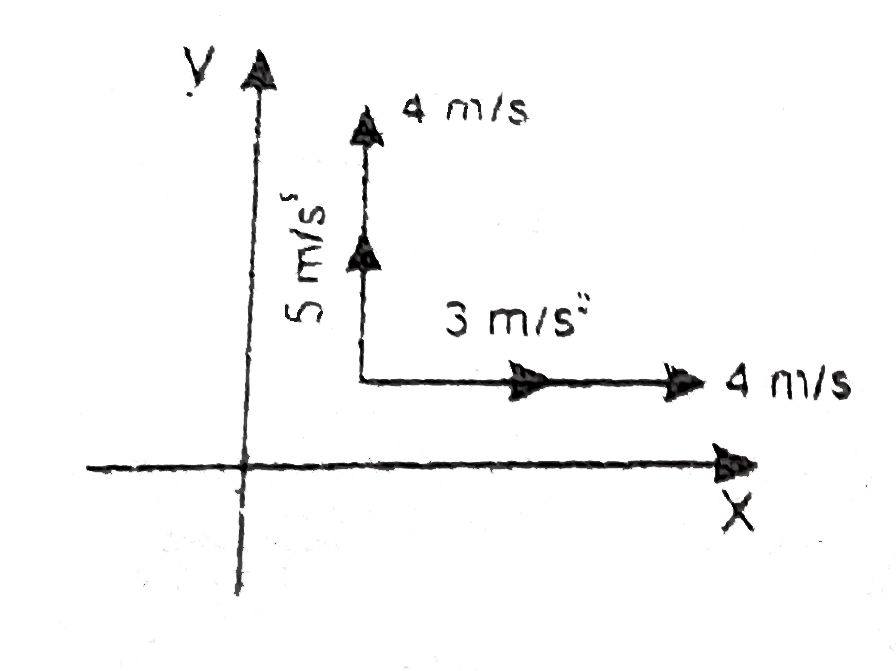A particle is moving in a circular path. The acceleration and momentum of the particle at a certain moment are a=(4ˆi+3ˆj)m/s2andp=(8ˆi−6ˆj)kg-m/s. The motion of the particle is
uniform circular motion
accelerated circular motion
deaccelerated circular motion
we cannot say anything with a and p only
The correct Answer is:B
To determine the type of motion of the particle moving in a circular path, we can analyze the given acceleration and momentum vectors. Let's break down the solution step by step.
Step 1: Identify the Given Vectors
We have:
- Acceleration vector a=4^i+3^j m/s²
- Momentum vector p=8^i−6^j kg·m/s
Step 2: Calculate the Magnitude of the Acceleration
The magnitude of the acceleration |a| can be calculated using the formula:
|a|=√(ax)2+(ay)2
Substituting the values:
|a|=√(4)2+(3)2=√16+9=√25=5 m/s2
Step 3: Calculate the Magnitude of the Momentum
The magnitude of the momentum |p| is calculated similarly:
|p|=√(px)2+(py)2
Substituting the values:
|p|=√(8)2+(−6)2=√64+36=√100=10 kg⋅m/s
Step 4: Calculate the Dot Product of Acceleration and Momentum
The dot product a⋅p is given by:
a⋅p=(4^i+3^j)⋅(8^i−6^j)=4⋅8+3⋅(−6)=32−18=14
Step 5: Use the Dot Product to Find the Angle
The dot product can also be expressed in terms of the magnitudes and the cosine of the angle θ between them:
a⋅p=|a||p|cosθ
Substituting the values we calculated:
14=5⋅10⋅cosθ
14=50cosθ⟹cosθ=1450=725
Step 6: Determine the Type of Motion
Since the acceleration has both radial and tangential components (as indicated by the non-zero dot product), the particle is undergoing accelerated circular motion. The tangential component of acceleration increases the speed of the particle, while the radial component changes its direction.
Final Answer
The motion of the particle is accelerated circular motion.
---
We have:
- Acceleration vector a=4^i+3^j m/s²
- Momentum vector p=8^i−6^j kg·m/s
The magnitude of the acceleration |a| can be calculated using the formula:
|a|=√(ax)2+(ay)2
Substituting the values:
|a|=√(4)2+(3)2=√16+9=√25=5 m/s2
The magnitude of the momentum |p| is calculated similarly:
|p|=√(px)2+(py)2
Substituting the values:
|p|=√(8)2+(−6)2=√64+36=√100=10 kg⋅m/s
The dot product a⋅p is given by:
a⋅p=(4^i+3^j)⋅(8^i−6^j)=4⋅8+3⋅(−6)=32−18=14
The dot product can also be expressed in terms of the magnitudes and the cosine of the angle θ between them:
a⋅p=|a||p|cosθ
Substituting the values we calculated:
14=5⋅10⋅cosθ
14=50cosθ⟹cosθ=1450=725
Since the acceleration has both radial and tangential components (as indicated by the non-zero dot product), the particle is undergoing accelerated circular motion. The tangential component of acceleration increases the speed of the particle, while the radial component changes its direction.
The motion of the particle is accelerated circular motion.
Topper's Solved these Questions
- CIRCULAR MOTIONBOOK - DC PANDEY ENGLISHCHAPTER - CIRCULAR MOTIONEXERCISE - More than One Option is Correct
13 Videos
- CIRCULAR MOTIONBOOK - DC PANDEY ENGLISHCHAPTER - CIRCULAR MOTIONEXERCISE - Comprehension
13 Videos
- CIRCULAR MOTIONBOOK - DC PANDEY ENGLISHCHAPTER - CIRCULAR MOTIONEXERCISE - JEE Main
23 Videos
- CENTRE OF MASS, LINEAR MOMENTUM AND COLLISIONBOOK - DC PANDEY ENGLISHCHAPTER - CENTRE OF MASS, LINEAR MOMENTUM AND COLLISIONEXERCISE - Level 2 Subjective
21 Videos
- COMMUNICATION SYSTEMBOOK - DC PANDEY ENGLISHCHAPTER - COMMUNICATION SYSTEMEXERCISE - Only One Option is Correct
27 Videos
Similar Questions
A particle is moving in a circular path. The acceleration and momentum vector at an instant of time are →a=2ˆi+3ˆjm/sec2 and →p=6ˆi−4ˆjkgm/sec. Then the motion of the particle is
View SolutionAt a particular instant velocity and acceleration of a particle are (−ˆi+ˆj+2ˆk)m/s and (3ˆi−ˆj+ˆk)m/s2 respectively at the given instant particle's speed is :
View Solution
Knowledge Check
The value of 'a' so that the vectors 2ˆi−3ˆj+4ˆkandaˆi+6ˆj−8ˆk are collinear
A4B−4C2D0
A particle velocity changes from (2ˆi+3ˆj)ms−1 to (2ˆi−3ˆj)ms−1 in 2 s. The acceleration in ms−2 is
View SolutionA particle is moving in xy-plane in a circular path with centre at origin. If at an instant the position of particle is given by 1√2(ˆi+ˆj), then velocity of particle is along
View SolutionA particle is moving with a constant acceleration →a=ˆi−2ˆjm/s2 and instantaneous velocity →v=ˆi+2ˆj+2ˆkm/s then rate of change of speed of particle 1 second after this instant will be :
View SolutionAssertion: Velocity and acceleration of a particle in circular motion at some instant are:
v=(2ˆi)ms−1 and a=(−ˆi+2ˆj)ms−2 , then radius of circle is 2m .
Reason: Speed of particle is decreasing at a rate of 1ms−2 .
View SolutionThe position vector of a particle moving in x−y plane is given by
→r=(Asinωt)ˆi+(Acosωt)ˆj then motion of the particle is :
View SolutionThe velocity and acceleration vectors of a particle undergoing circular motion are v=2ˆim/sanda=2ˆi+4ˆjm/s2 respectively at some instant of time. The radius of the circle is
View SolutionA particle is moving in x-y plane. At an instant, it has velocity (4ˆi+4ˆj)m/s and acceleration (3ˆi+5ˆj)m/s2 At that instant, the radius of curvature of its path will be :

View Solution
